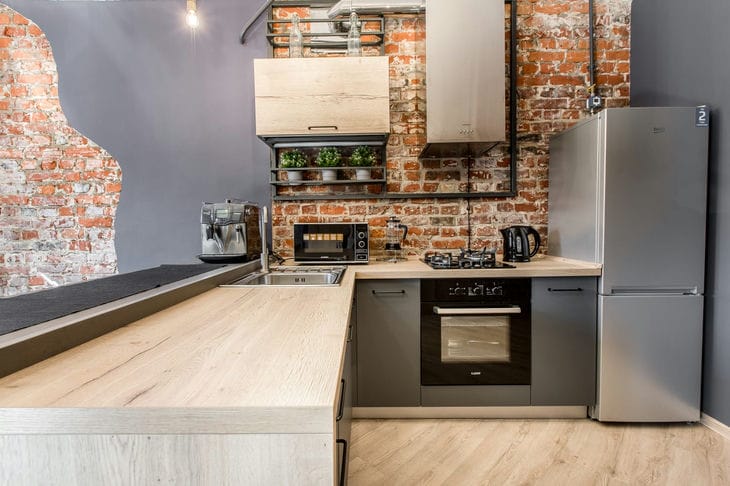There are many requirements for kitchen walls.
They are exposed to extreme conditions on a daily basis – dirt, high temperatures and moisture.
They must be durable and resistant to frequent cleaning.
In addition to practical considerations, their aesthetics are also important. Yulia Tychino explains which materials, besides traditional tiles, are suitable for kitchen walls.
Ceramic tiles
Ceramic tiles in the kitchen still remain a popular solution, although they are gradually being replaced by more modern materials.

The tiles are easy to clean, and the richness of patterns and colors creates great opportunities for their installation. They are resistant to water, grease and frequent washing.
If you prefer classic solutions, it is worth choosing tiles covered with a thicker layer of glaze. Glazed porcelain and clinker are also suitable.
Glass
Glass panels will look good in modern kitchens. They are available in various colors and textures, which creates a large field for creating a stylish interior.
Multicolored lacquer is actively used. In addition to visual advantages, the disadvantage of glass panels is their sensitivity to scratches.
Sheet metal panels
This is certainly an extraordinary finish, which only a few have chosen so far. This is due, rather, to its aesthetic qualities, which naturally fit better into industrial interiors, which are not yet very popular.
Metal walls are easy to keep clean, and an added benefit of having them is their practicality - thanks to magnets, you can quickly attach various kitchen utensils to them.
Dye
The paint market today offers a huge selection of durable, water-resistant, and abrasion-resistant products. Look for paints with a durability class of I or II, which will allow them to be cleaned with mildly abrasive chemicals.
Painting the walls, compared to the other solutions mentioned above, is relatively cheap and does not require much time. If your color preferences change, you can quickly update the kitchen layout.
Wallpaper for walls
Wallpaper is also an interesting option. Since it comes in a variety of patterns and colors, you can easily create an intriguing space using it.
In the kitchen, the most durable laminate and fiberglass wallpaper are best. Thanks to special PVC coatings and installation on a cotton mesh, they will be more durable and resistant to water vapor.
Tree
Thanks to new production and impregnation technologies, kitchen walls are increasingly being covered with wood or wood-based materials.
Depending on your preferences, you can choose wooden and laminated panels, waterproof plywood, veneered chipboard and laminates, of course, properly protected from water and grease.
The panels will serve you flawlessly for a long time if the fastening system with which you attached them to the wall plane does not create gaps through which water vapor gets.
Composites and conglomerates
Composites such as Corian, Staron or Kerrock are made from a mixture of minerals, synthetic resins and pigments.
They are "warm" and pleasant to the touch, and are also resistant to various "kitchen ailments" - high temperatures, scratches, greasy stains and dry cleaning. Their disadvantage is the high price.
A cheaper solution would be conglomerate materials – marble, graphite, quartz.
They are made from crushed natural stones combined with polyester resin or cement and dyes. They are slightly cheaper than composites, but retain similar properties - they are not damaged by moisture, temperature, detergents and abrasion.
Decorative plaster
You can also treat the kitchen walls with decorative plaster. Thanks to its use, you can easily revive the kitchen interior without changing the equipment. This is a great alternative to paints and wallpaper.
This allows you to get non-uniform surfaces that resemble the selected materials, such as granite. Walls finished in this way will not get dirty if they are additionally secured with a sealant.
Architectural concrete
Architectural concrete is a good option for people who prefer inexpensive, but more environmentally friendly solutions.
You can fit this material not only to a loft or industrial interior. Together with more delicate accessories, it will create an impression of "coziness".
Its other advantages include resistance to kitchen conditions, but it is important to install it correctly (with strong glue or screws). After covering the walls with it, it is recommended to soak them twice with a special agent intended for this purpose.
Brick
Clinker bricks are used in kitchens almost as often as regular tiles. They are very versatile - they will look good in modern and rustic arrangements. Protected with impregnation, they will be resistant to greasy stains and moisture.
Stone
If you want durability, it is worth choosing natural stone for the walls in the kitchen. It is easy to maintain, durable and resistant to scratches and high temperatures. Before installing on the wall, do not forget to properly insulate and protect the walls.
Earlier we wrote about how to conveniently arrange a small hallway.









